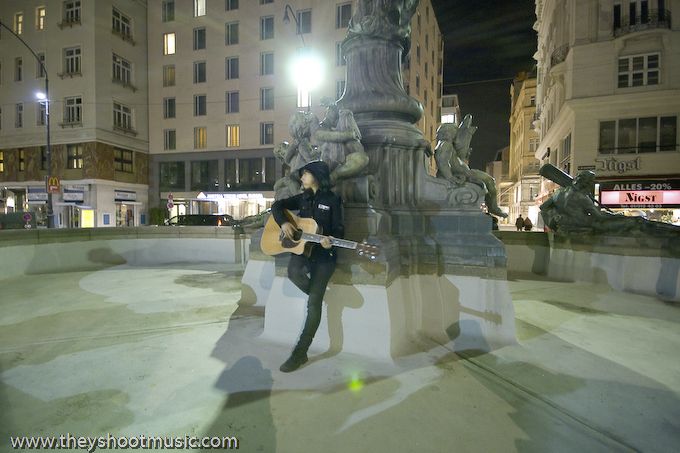Tiny Vipers
Neuer Markt, 2010
„Are the tourists gone?“, Jesy Fortino aka Tiny Vipers asks. The Seattle-based songwriter doesn’t really feel comfortable playing in the streets, while there’s still a group of loudly talking and laughing men around. When the voices grow quieter and finally disappear in the streets of Vienna’s inner city, Jesy starts fingerpicking the first notes of „Dreamer“. She stands in an empty fountain, in the middle of Neuer Markt, a square that is already pretty deserted in these early evening hours in mid-March. It seems like she prefers playing just for herself, and every interaction from the outside world would break this fragile, dark, yet beautiful intimacy she creates with her songs. For the second song, „Aron“, she then suggests to sit in a niche of the fountain sculpture, so that no one from the street can see her. Only the camera slowly moves around. Jesy is not the kind of musician who tries to entertain people. She demands close and attentive listening and gives back unconventional and haunting songs of strong emotions – no matter if she is onstage or sits in a fountain.
- Camera
- Michael Luger
- Sound Recording
- Sarah Brugner
- Post production
- Michael Luger
- Photography
- Simon Brugner
- Artist
- Tiny Vipers




Neuer Markt
Only a few footsteps away from the touristy hustle and bustle of Kärnter Straße, Neuer Markt is a far more quiet square, but well worth seeing. It is one of Vienna’s oldest squares, first mentioned in 1234. In medieval times, when it turned out that Hoher Markt as a market square was not sufficient any more for the food supply of the Viennese people, Neuer Markt was created for selling flour and corn, which is the reason why the square was inofficially called Mehlmarkt (flour market) until the 20th century. These days Neuer Markt’s main attraction is the Kapuziner church, which dates back to 1632 and has the famous Kapuzinergruft underneath, where 31 Habsburg emperors and empresses are buried in impressive coffins. Another reason for walking across Neuer Markt is the Donnerbrunnen (thunder fountain) in its center, which was built by Georg Raphael Donner in the early 18th century. It is a replica, though. The original bronze sculptures can be found in the Belvedere Gallery. In the 1980s, the fountain often served as a meeting point for Viennese Mods and other subcultural movements.